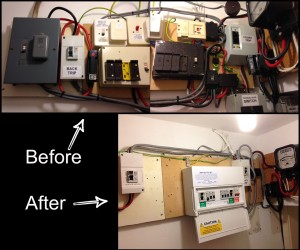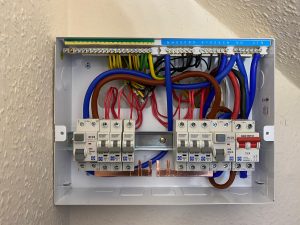The consumer unit is the source and distributor of the different electrical circuits in your property, where the mains power, having passed through the electrical meter, then gets distributed to the different electrical circuits in the building, and hence the electrical accessories eg. sockets, lights etc. Getting the right consumer unit for your needs and the application is very important. We are here to help you get the right consumer unit, to understand how it works and are very happy to install it for you.

An old fuseboard is replaced with a modern consumer unit with miniature circuit breakers (MCB) and residual current devices (RCD).
Fitting a new consumer can be quite an involved job, where the power needs to be switched off for a few hours and each circuit connected to its relevant protective device. Both before and after powering up, thorough electrical testing is carried out and recorded as an Electrical Installation Certificate. This is presented to the customer on completion of the job and also submitted to building control. That is why it is imperative the installing of the consumer unit is carried out by a competent electrician.
When to replace a consumer unit?
Every house will have either an old fashioned fuse board or a consumer unit as the place where circuits are protected (with fuses or MCBs (Miniature Circuit Breakers) and can be isolated (ie turned off). So when to change a consumer unit? Why upgrade the consumer unit? If the old one has worked up until now why change it? There are a number of factors to consider:
-
- It may be that you have had an electrical installation condition report carried out and the report has recommended that the consumer unit/fuse board be replaced. If you are unsure why you can discuss this with the electrician who carried out the electrical test and inspection.
- If you have a fuse board (ie. the circuits are protected with fuse wire rather than MCBs) then there are a some important differences consumer unit vs fuse box that you should be aware of.
Regarding fuse boxes:- The type of circuit overload protection will have longer disconnection times. What that means is, if there is too much current being drawn on a circuit (may be too many electric heaters are on one circuit) then the fuse wire will blow (or MCB trip off) in order to protect the cable from overheating and eventually melting.
- It is actually quite difficult and potentially dangerous to replace the fuse wire after it has blown. The fuse wire may ‘blow’ on a dark winters evening, causing the lighting circuit to switch off, just when you need to see what you are doing to replace the fuse wire. You then have to remove the cover on some fuse boards to get to the fuse, which means live parts are exposed. Then it can be quite fiddly undoing the screw and threading the fuse wire into the fuse holder, all while you are crouched on your knees in the under stairs cupboard in the dark! Not ideal.
- There is likely to be no RCD (Residual Current Device) protection on a fuse board – more on this later. This means you and your family are more susceptible to an electric shock in the event of an electrical fault. The fuse (or MCB) will protect the cable, however, the RCD will protect you should you touch a live part of the installation. In that event, you become a part of the electrical circuit and some current flows through you to earth. This creates an imbalance in the current which has flowed out from the supply compared to what has flowed back. The RCD picks up this imbalance and trips off.
Some old fuse boards may have an old fashioned earth leakage device sited before the fuseboard. However, these will not meet the higher modern standards and best replaced. They deteriorate over the years and don’t trip off in the required time.
- If you have built a new garage, shed or outhouse you will need a new consumer for that building. The same will most likely be true for building an annex or extension on your house. It is always more preferable to run in one new supply cable to the new area and feed new circuits out from there, rather than extend a number of existing circuits to the new areas.
- There are occasions where you are already have a consumer unit (ie MCBs) and it’s still appropriate to ask the question, why upgrade the consumer unit?Here’s some reasons:
- The consumer unit may not have enough ‘ways’ to accommodate some new circuits being added to the installation.
- The MCBs may be very old and deteriorating.
- There may be no RCD protection on the consumer unit.
- The consumer unit may be damaged, not be securely fixed or have an inappropriate IP rating (ie large holes allowing possible electric shock for prying fingers).
- You are having new circuits run in the house and want to be sure all the associated electrical installation is new and complies with the latest regulations.
- For some older consumer units if you require a new circuit breaker (MCB) or a RCBO (residual current breaker with over-current) the manufacturers sometime charge an exorbitant amount to make it more cost effective to replace the whole consumer unit. Which, to be honest, is the better option for you.
Which consumer unit is best?
Customers often ask me which consumer unit do I need? Which consumer unit should I buy? In order to arrive at the best solution let me ask you a few questions:
- Where is the consumer unit to be located? (In the house? In the garage? Outside?)
- How many circuits will it need to serve?
- In the event of a circuit fault would you prefer minimal disruption (ie only one circuit tripping off rather than many?)
- What is more important to you – quality or budget?
- Do you require addition protection such as SPD’s and AFDD’s?
We can provide advice for you to help answer the above questions to ensure you have the answer to the question what consumer unit do I need for my house? What is best for one customer won’t necessarily be the best for another.
Some basic guidelines I would suggest would be:
- Try to buy the most expensive consumer unit you can afford.
When you spend more on a consumer unit you will have better quality components in the board. The MCBs and RCDs could save your life, so why skimp on cost.
Consumer units which are cheap are generally also ‘nasty’. The breakers may become unreliable, and don’t fit correctly in the spaces provided, screw threads strip and the consumer units can be awkward to install. Generally it is better to let the electrician installing the board choose which one to buy for you. They would have installed many different types over the years and discovered which ones are nicer to install (which means less labour cost for you) and that tends to be the one they stick with. That means they become very familiar with how best to install that product, and so you will get a neat and professionally installed consumer unit.
Bear in mind also, that under the latest wiring regulations (18th edition) all newly installed consumer units must be constructed of metal – the reason being metal consumer units are better at containing the spread of a fire. So if you have picked up a ‘so called’ bargain for a plastic consumer unit, you won’t be able to have it installed unless it is contained in a large metal enclosure (which could end up costing you more than a metal consumer unit!) - Allow for more circuits than you have
When fitting a new consumer unit you want to futureproof as much as you can by ensuring you have a few spare ways on the board. So for example if the house has 8 circuits in use I would recommend fitting a 10 way board. Then if you have a log cabin built in the garden you have a spare space for a MCB for the log cabin circuit. - MCB’s or RCBO’s?
Modern consumer units have two different structures:- 1. Split load or dual RCD consumer units.
- 2. RCBO consumer units.
First to answer why a split load consumer unit (or why a dual RCD consumer unit)?
This is where the consumer unit has a main switch (to isolate power to the whole consumer unit) and then 2 RCDs – each of which can isolate power to half of the circuits. That means if one of those RCDs trips off in a fault, then all the circuits and MCBs it is protecting will lose power. As you can imagine, this would be very disruptive in a situation where you have lost power to half the circuits in your house.
In contrast, the RCBO consumer unit, has a main switch again, but each circuit is protected by an RCBO (which is in effect an RCD and MCB in one unit). In a fault condition only the one RCBO covering the circuit with the fault, would trip off. Causing much less disruption, while you wait for the electrician to fault find for you.
RCBO consumer units do cost more, but they are a much better option for the reasons just described.
- Consumer unit without RCD protection
There are occasions where a consumer unit without RCD protection can be legitimately used in an application. One such example may be a shed requiring a sockets circuit and lighting circuit. This is fed from an armoured cable, say from a circuit on the main consumer unit in the house. Provided the supply circuit on the main consumer unit is RCD protected, and the appropriate disconnection times are met, then the consumer unit in the shed doesn’t need another RCD. In fact, it could be a nuisance to have two RCDs on the same circuit – as you don’t know which one would trip in the event of a fault. (There are situations where you can use different rated RCDs to prevent this – that is beyond the scope of this article). - Consumer unit with SPD’s and consumer unit with AFDD’s
As the wiring regulations are progressively added to over the years, improvements and developments are made to increase electrical safety. Two such additions in recent years have been surge protection devices (SPDs) and arc fault detection device (AFDDs).
Surge protection devices, are placed in a consumer unit to protect all the circuits downstream from large voltage surges (or spikes) such as lightning strikes or voltage surges. This is particularly pertinent where there is expensive, sensitive electronic equipment which might be susceptible to damage from increased voltages. A consumer unit with surge protection will protect those devices by cutting off the power before it reaches the circuits in the property.
Arc fault detection devices are devices intended to mitigate the risk of fire in final circuits of a fixed installation due to the effect of persistent arc fault currents. If a circuit has a fault where a spark is produced, it wouldn’t trip the MCBs or RCDs but it could still present a significant danger.
Both of these devices are not mandatory under the 18th edition wiring regulations but they are available should you wish to have that level of protection in your installation. - Which consumer unit to buy?
Every electrician will have his favourite consumer units to install, each with their pro’s and con’s. If you have a larger budget then Hager and MK are a good quality product and nice to install. If you require RCBO’s but don’t want to spend out quite as much as you would for Hager then Lewden boards are worth considering.
How does a consumer unit work?
So just how does a consumer unit work? There are a number of components to consider – main switch, MCBs, RCDs, busbar and the incoming and outgoing cables. Let’s the journey of the electricity as it enters a dual RCD consumer unit. The description should give you a better idea of how to wire a consumer unit.
The mains cables (otherwise known as the consumer unit tails) coming into the consumer unit, usually have a cross-sectional area of 25mm2 and are cable of carrying up to 100A. These should enter via a consumer unit tails gland or sometimes it enters the consumer unit from the back of the board. The tails then feed into the top of the main switch.
If the mains switch is put in the OFF position then no power will be fed into the consumer unit.
On the bottom of the main switch are connected the interconnecting cables for feeding power to each of the RCD’s. Each RCD will have its own neutral terminal bar. It’s important the neutrals from one RCD are not mixed up with the neutrals from the other, otherwise we will get nuisance tripping of the RCD.
Once the current has fed through the RCD, the busbar (solid copper bar under the MCBs) carries the electricity into each of the circuit breakers (MCBs). If each individual MCB is in the ON position the current will flow through onto the final circuit attached on the top terminal of the MCB.
The current flows through the circuit, around the house to each socket, light etc.
Should a circuit exceed the current rating on the MCB then the MCB will trip off. Should there be a current imbalance greater than the stated current (typically 30mA) on any of the circuits covered by the RCD, then the RCD will trip off.
FAQ
Where to fit a consumer unit?
Consumer units are often placed in hidden away locations which can be difficult access – which is not ideal. If a consumer unit is being changed, it is normally the case that it will be replaced in the same location. (It is possible to relocate a consumer unit, but it involves, among other things, lengthening (or shortening) each cable entering the consumer unit).
Where you are fitting a new consumer unit the regulations state it should be easily reachable and be mounted with the switches at a height of between 0.45m & 1.2m above floor level.
A consumer unit should ideally not be fitted in a bathroom, near a gas meter or in a location which is very humid or outdoors (unless the consumer unit has a suitable IP rating).
What consumer unit should I use for a garage, shed, log cabin etc?
It is often the case that these locations may only require two circuits (normally a socket circuit and a lighting circuit). In that case, a 2 way garage unit (with or without an RCD) would suffice for this scenario.
When a consumer unit is changed does the earthing need upgrading?
The condition of the earthing conductor and the earth bonding cables will be inspected on the site survey and if they are the wrong size or in a bad condition then they should be replaced. However, in many cases the earthing is suitable to reuse in the new consumer unit.
What should I do if the consumer unit is tripping?
If any of the switches in the consumer unit trip off the first thing to try is to switch them back on. Sometimes an RCD may trip off if an old style incandescent light bulb blows. The RCD can simply be switched back on; change the light bulb and away you go. However, if the tripped switch trips itself off again, ie it simply won’t stay in the on position then there is likely to be a fault on the circuit.
One thing to try, is to unplug all the appliances in the house connected to the problem circuit and then try to switch it on again. If it tips now, then you know it is an issue with the electrical installation. At this point it is best to call us for assistance.
If you require help in deciding whether to upgrade your consumer unit or have a new consumer unit installed in your property, then do give us a call and we’d be happy to provide you with a quote.






